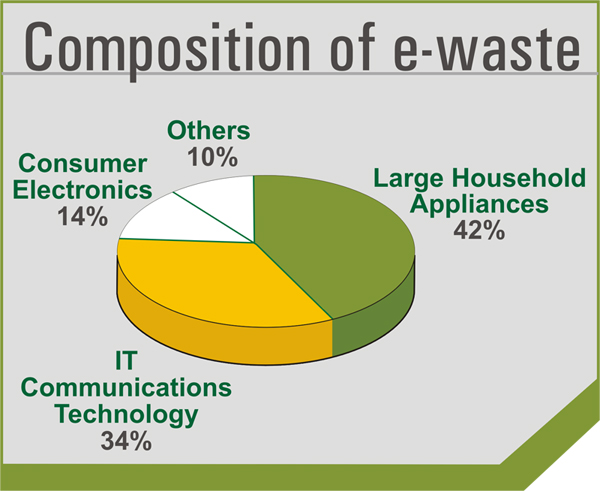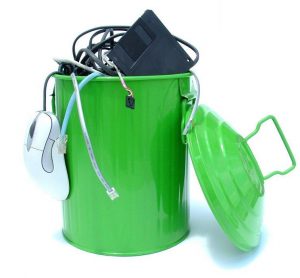‘e-Waste’ is generally applied to consumer electronic devices and gadgets that are near or at the end of its immediate useful life.
In the midst of e-revolution, we change our gadgets almost as often as we buy new clothes. Electronic equipment, especially computers, are often discarded by households and businesses not because they are broken but simply because new technology has rendered them obsolete and undesirable. Sometimes, the new software is incompatible with the older hardware leaving customers with no option but to buy new ones. Data from a single-day recycling collection event revealed that more than 50 per cent of rejected computers are in good working order, but they are discarded nonetheless to make way for the latest technology.
Some of the consumer products like refrigerators, televisions and so on were once a lifetime purchase. These days it’s cheaper to throw that broken DVD player, mobile device or TV out and buy a new one leading to ‘replace-rather-than-repair’ mentality.
So what happens to these outmoded appliances when you replace it with the latest model? Or where does a battery go when it is tossed in the trash? Around the world, end-of-life electronics or discarded obsolete cell phones, computers, notebooks, computer game consoles and other electronic devices also known as e-waste, present a significant challenge for our environment and our health.
In Indonesia, with the growth in economy and fast development in technology, the total estimated accumulation of generated e-waste from just households from 2015 and 2025 will triple.
Some e-waste facts:
- Most of the home appliances, computers and mobile phones tossed out are never recycled.
- By 2017, the volume of discarded e-products worldwide was 33 per cent higher than in 2012 and weigh the equivalent of eight of the Great Pyramids of Egypt.
- 300 million computers and 1 BILLION cell phones are put into production each year. This global mountain of waste is expected to continue growing 8% per year, indefinitely
- The Environmental Protection Agency estimates that only 15-20% of e-waste is recycled, the rest of these electronics go directly into landfills and incinerators
- It’s foreseen in 2030 that developing countries will discard 400 million — 700 million obsolete personal computers per year compared to 200 million — 300 million in developed countries.
- For every 1 million cell phones that are recycled, 15000kg of copper, 350kg of silver, 20kg of gold, and 10kg of palladium can be recovered.
- It takes 250kg of fossil fuel, 20kg of chemicals, and 1.5 tons of water to manufacture one computer and monitor.
What can you do reduce your e-waste? How to begin?
Awareness is the key to being GREEN. Becoming aware of the effects of e-Waste is the first step in arresting this problem. We tend to forget that properly disposing of or reusing electronics can help prevent health problems, create jobs, and reduce greenhouse-gas emissions.
The single most effective way to cut down on your e-waste is to stop buying electronics. Ask yourself: Do I need this or just want a new toy?
-PIC-
Some conscious actions can extend your current electronics’ lifespan, especially your computers. Here are six some simple tips:
- Add memory to computers.
- Perform a “clean install” of operating systems every three years to keep computers running quickly.
- Old computers generally run best with old software, so avoid upgrading to latest software unless you need to do so.
- Defragment hard drives monthly. Most computers have built-in utilities that can be set to defragment the hard drives regularly.
- Keep computers out of direct sunlight. If they overheat, their internal components could be irreparably damaged.
- Reboot computer as needed.
- As you open and close applications, fragments of memory can build and slow down a computer. A reboot cleans out these fragments.
- Dust around your computer can trap heat inside the machine, causing cooling fan to run longer. Clean the fan on the power supply and blow out the dust from inside the computer to prevent the computer from wearing out.
Be more aware of the impact your home or office e-waste has on the environment. Do not just throw away your old computer monitor or a broken phone in trash; take time to research how you can discard those in the most environmentally friendly way. Electronics that are in working condition can be donated to the less fortunate, to schools and to those who can reuse them. A simple phone call can prevent your computer from becoming part of a landfill and you make into a citizen that is environmentally conscious and responsible.
In addition to following the general 3Rs rule; Reduce, Reuse and Recycle, there are 2 additional steps – Avoid and Evaluate.
Avoid
- Buying new equipment if you can get it fixed.
- Buying disposable products. Only buy products that are durable, repairable and have a good warranty.
- Consider leasing equipment that can be returned to the manufacturer when it is no longer needed.
- Engage service providers who replace and refill components of leased equipment when they have been used.
- Toners and some inks are now being produced with biodegradable oils such as soybean oil, which are much less toxic than petroleum based toners and inks.
Evaluate
Evaluate, compare and select electronic products based on environmental attributes such as:
- Energy use. Look out for the energy star rating
- Lifespan
- Level of toxic materials
- Ease of recyclability
Reduce
- Where economically feasible, repair machinery, appliances and equipment in preference to purchasing new equipment.
- Regularly service and maintain equipment to prolong lifespan of the products.
- Check around local schools/charities to see if they can use your surplus appliances.
- There are many companies that will refurbish your old computer equipment for use by those who cannot afford new items.
- Many ink cartridges can be refilled with ink for reuse using toner refill kits.
- Alkaline batteries can be recharged.
Recycle
- If you decide to buy any new equipment, check with the manufacturer about reuse and recycling options. Often these programs will take older computer parts in exchange for credits towards the purchase of new equipment from the manufacturer.
- Take electrical goods and scrap such as copper wiring to electronic recyclers.
- Cathode ray tubes of televisions and computer screens can be recycled.
Being GREEN is a mindset. Technology is often seen as a solution to all problems and the negative aspects are underplayed or ignored. Simple actions can decrease your environmental footprint significantly. Look beyond the marketing for the latest device and make conscious choices as a responsible resident on planet Earth.
By Poonam Sagar






